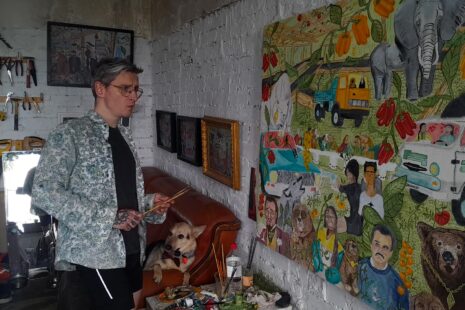Mexican born and based artist Débora Delmar shot to internet fame last year when the logo of her pseudonym, Debora Delmar Corp, was spotted on the hips of Cara Delevingne and Jourdan Dunn sparking a debate about ownership and consumerism in the world of contemporary art. Skip forward a year and now after her first solo show, ‘Upward Mobility’, at Modern Art Oxford, Independent Collectors speaks to Delmar about what collectors mean to her practice, how her views on capitalism could potentially affect her relationship with a collector, and just how important are collectors to the art world.
IC: How important is the role of a collector to an artist?
Débora Delmar: Collectors are as important to young artists as investors are to new businesses. I think it’s important for artists to find collectors that truly believe in their brand because they appreciate their vision as artists and somehow also share this vision.
Do you have a particular collector that is present in the creation of your work?
I don’t, but I’m interested in the relationship between artist and collector in my work. One of my works (which is meant to be for sale at art fairs only and is also a unique work that can´t be replicated) titled ‘Branded for Life’ involves a collector and I getting my ‘DD’ logo tattooed on the side of our hips and documenting it in the same way as supermodels Cara Delevingne and Jourdan Dunn who last year got matching tattoos of the exact same double-D emblem on their hips. Artist and collector will then share the experience and the rights.

Last year the BFF tattoos between Cara Delevingne and Jourdan Dunn were talked about a lot. In some way, do you think this could be seen as an act of art collecting?
I think so. I really like that idea.
What would the art world be like without the role of a collector?
Collectors have always been in the art world, starting with the Medici as probably the most well known. It would be hard to imagine artists that don’t necessarily come from wealthy backgrounds like Duchamp, who never worried about making a living, to be able to produce work or even to think about becoming artists without the support of people who believe in their work and these people are collectors, institutions, curators and gallerists.
Has a collector ever commissioned work from you? How do you approach a commissioned piece of work?
I’ve been mostly commissioned by institutions, which have always resulted in great opportunities to make more ambitious series of works, allowing me to experiment with my own way of producing work. I usually start by thinking of the space where the work will be exhibited, and then by planning a concept for what I want to make. I then go through more of a research phase thinking of which materials, objects or images I’d like to use and how I want them to exist in that specific context but also thinking how they will function as works.
Is it important for you that your work is shown in a publicly accessible collection rather than a private one?
I believe there are different works for different types of collections in terms of public and private ones. I’m interested in the collectors that will take a chance and collect works that require a very particular interest and that may not only be something to hang easily on a wall. I was very happy when I went to a Mexican collector’s home and saw that he owned an Adriana Lara’s installation (‘Banana Peel’). His entire home seemed to have been built in order to display the art he owned, rather than the other way around, which was very interesting to see and experience. But I believe it’s important for public institutions to collect and exhibit contemporary art since at the end of the day it is through public institutions that most people get to experience art.
Your work often surrounds the idea of advertising, consumerism. How does this affect your relationship with collectors?
Advertising and consumerism are global issues which affect everyone on a daily basis in the globalized world, so I think me talking about these subject matters through my work concerns collectors the same way as it does concern the audience that encounter my work.

Courtesy the artist

Courtesy the artist
Source: Independent Collectors

















